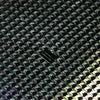Silicon Wafer with Early Bipolar Transistors - 1 inch, 30mm, Planar, Fairchild?
About this Artwork:
Fabricated around 1960, this silicon wafer is one of the earliest made. It is paper-thin and only 30mm in diameter (today’s wafers are 12” in diameter). Wafers of this size are very rare. The wafer contains over 160 bipolar planar transistors. The background artwork is a micro-photograph of the 16 transistors on the wafer. I believe these to be early Fairchild transistor wafers since these were included in a box of incomplete 2” Fairchild logic wafers I purchased many years ago. The box belonged, at some point, to a Dick Hagar (could find no information.) It was labeled 1971 and had a Fairchild logo on it. It is possible this wafer was an experimental version as it was hand-etched with a serial number at the lower right of the wafer.
About the Planar Process:
Jean Hoerni invented the planar transistor in 1959 and it is possible that this wafer was part of his research. The Fairchild 2N1613 planar junction transistor was introduced in 1960. Prior to the planar transistor, transistors were created in grown crystal formations that were somewhat 3 dimensional. The planar transistor was created in a more 2 dimensional, or planar, fashion that was easier to manufacture and had a much longer lifetime. The transistor was built with layers of doped silicon and aluminum. Layers of silicon dioxide were used as insulators and guides for etching. The invention of the planar transistor was the quantum jump in technology needed to create the silicon integrated circuit. It was a natural extension when Robert Noyce used Hoerni's method to connect multiple transistors together to create an integrated circuit on a single piece of silicon. Planar technology can be used to implement most types of transistors, including Bipolar and MOSFET.
Framing:
The artwork is framed in an 8"x 8" black shadow box frame, with glass. All framing materials are acid-free. A narrative about the artwork that includes the artist’s signature is placed on the back of the artwork.
Please note: The look of the artifacts in the artworks may vary, each piece is unique.





